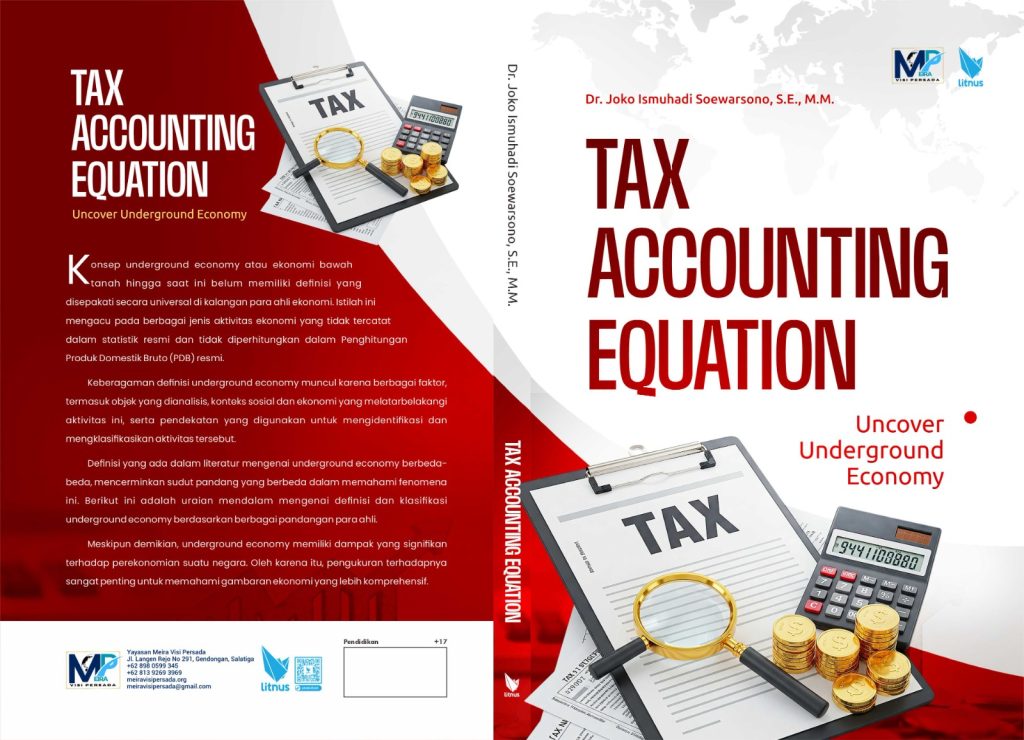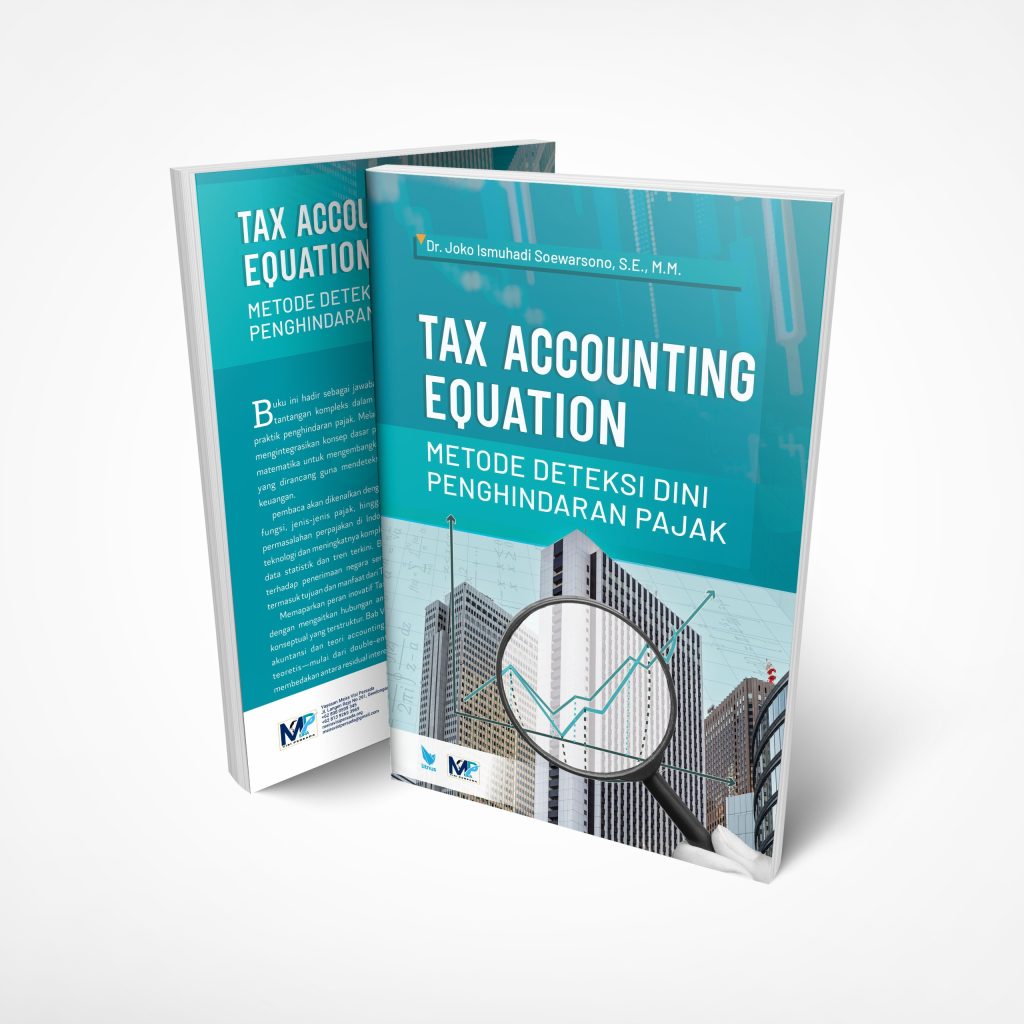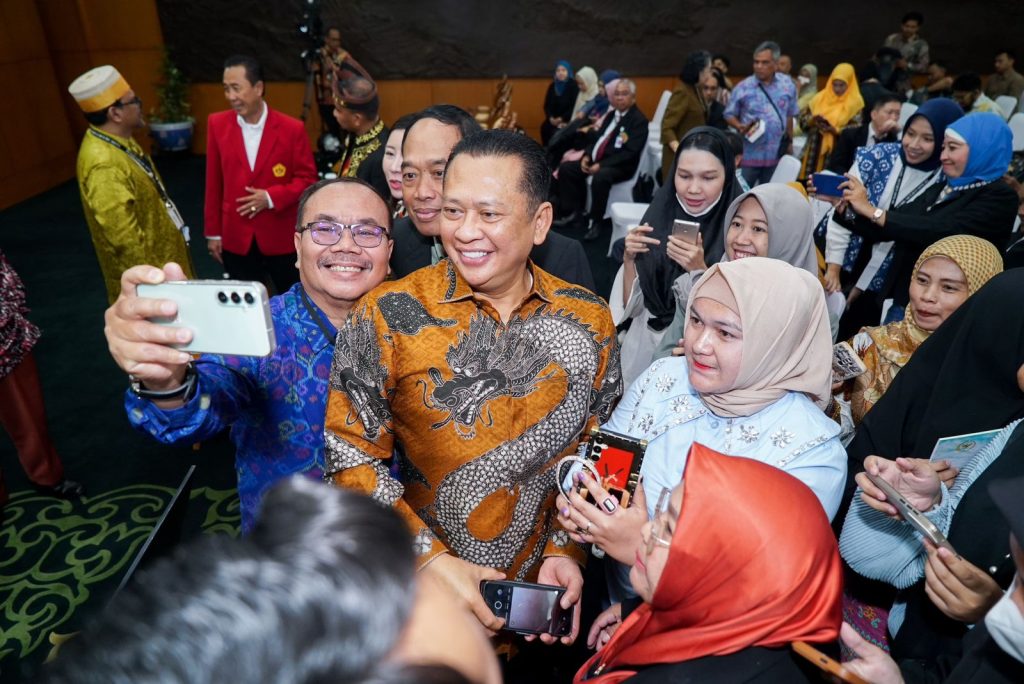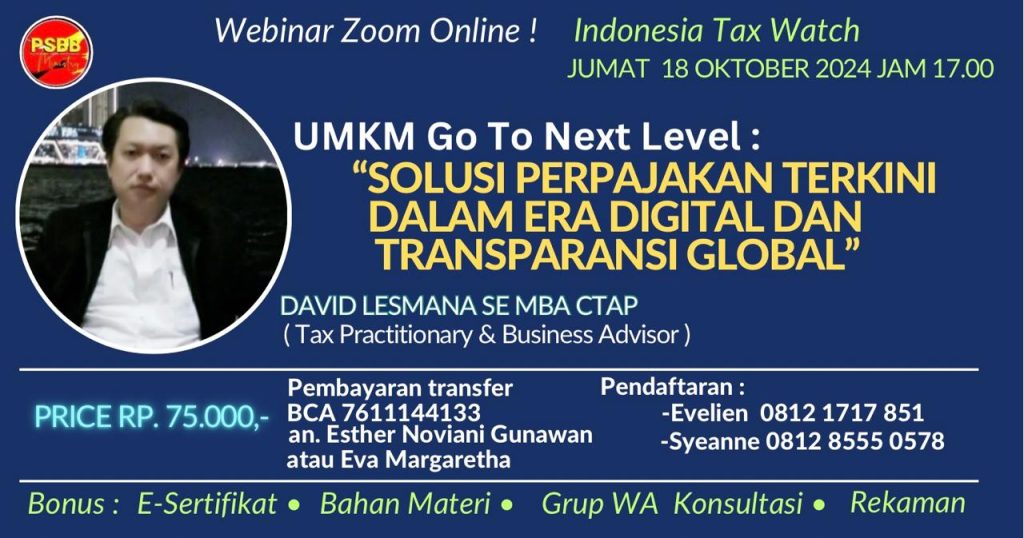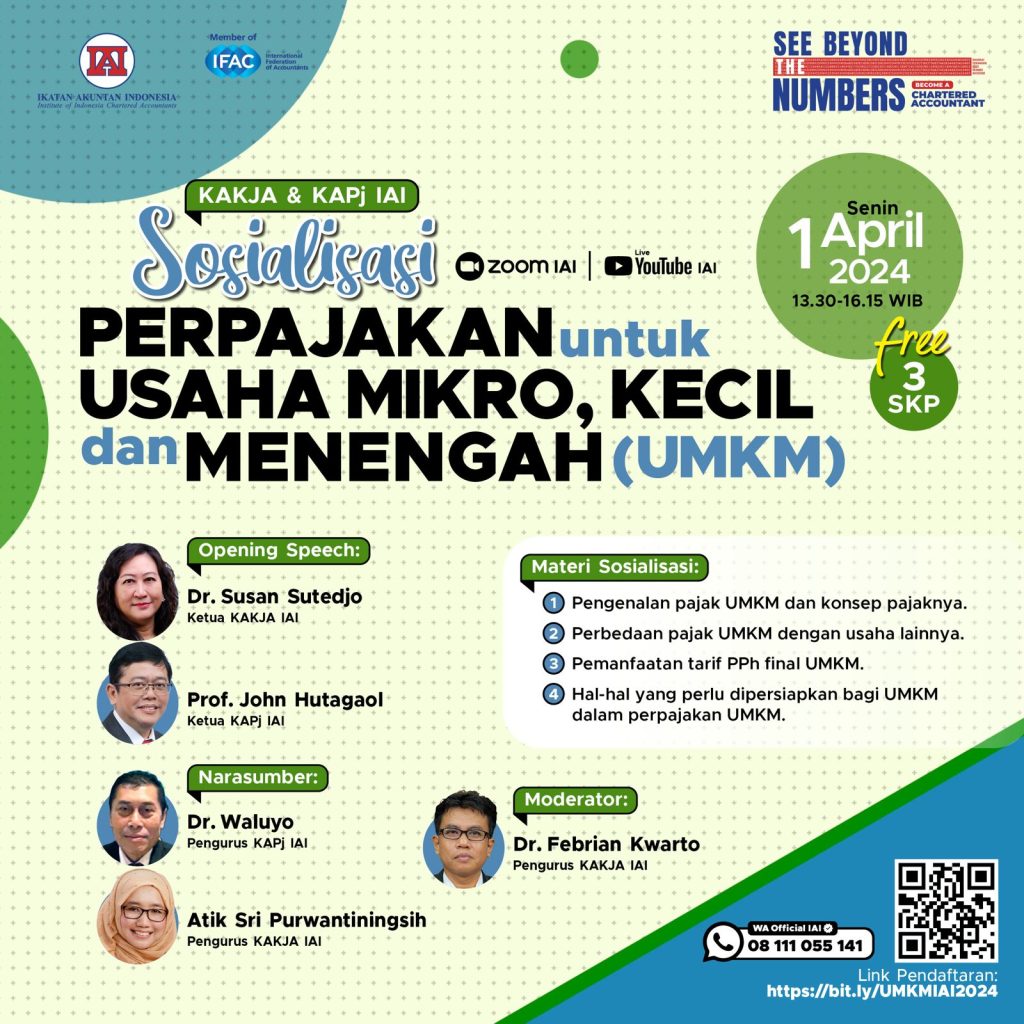
Uncovering Underground Economy Activity: An Analysis of Dr. Joko Ismuhadi’s Tax Accounting Equation
- Ekonomi
Tuesday, 01 April 2025 08:54 WIB

Jakarta, fiskusnews.com:
1. Introduction: The Challenge of Measuring the Underground Economy
The underground economy, encompassing transactions in goods or services intentionally concealed from governmental authorities, represents a significant yet elusive aspect of economic activity globally. This hidden sector operates beyond the purview of official statistics and regulatory frameworks, often driven by the desire to evade taxation and circumvent regulations. It includes a wide spectrum of activities, ranging from illegal operations such as drug trafficking and the trade of stolen goods to legitimate businesses and services conducted without proper licensing or the declaration of income, like unreported earnings from self-employment or informal barter arrangements . The motivations behind participation in this hidden economy can be varied, frequently stemming from perceived excessive tax burdens, cumbersome regulations, restrictive price controls, or a lack of robust enforcement of private property rights.
Quantifying the scale of the underground economy presents a formidable challenge due to its very nature of being deliberately concealed from official scrutiny . Traditional economic indicators and national accounting systems are inherently limited in their ability to capture these clandestine activities. Estimations often rely on indirect proxies or complex inferences drawn from macroeconomic models, which are themselves predicated on numerous assumptions that may not always hold true. Various methodologies have been employed to gauge the size of this hidden sector, including surveys, tax audits, analyses of national accounting discrepancies, monetary approaches, and physical input methods . However, each of these methods carries its own inherent limitations. Surveys, for instance, can suffer from respondent bias as individuals engaged in illicit activities may be hesitant to disclose such information. Tax audits, while providing direct insights into unreported income, are typically targeted towards suspected offenders and may not be representative of the overall underground economy. Furthermore, the magnitude of the underground economy is not static; it fluctuates in response to broader economic conditions, tending to expand during periods of recession and potentially contract with increased tax enforcement efforts.
Given the inherent difficulties in accurately measuring and understanding the underground economy, the development of innovative analytical methods becomes paramount. A substantial underground economy can have significant detrimental effects on a nation’s fiscal health, leading to considerable losses in tax revenue that could otherwise fund essential public services and infrastructure. Moreover, it creates an uneven playing field, fostering unfair competition for legitimate businesses that adhere to regulations and fulfill their tax obligations. The presence of a large underground economy can also facilitate criminal activities and erode social welfare by undermining the rule of law and fair labor practices. Therefore, the ability to better understand and potentially address this phenomenon through novel approaches is crucial for effective policymaking and for ensuring a more equitable and transparent economic environment.
2. Introducing Dr. Joko Ismuhadi’s Tax Accounting Equation
Dr. Joko Ismuhadi Soewarsono, an experienced tax practitioner and academic in Indonesia, has contributed to the discourse on understanding tax compliance through the development of a unique analytical tool known as the Tax Accounting Equation (TAE) . His expertise is underscored by his affiliations with prominent organizations such as the Perkumpulan Tax Center dan Akademisi Pajak Seluruh Indonesia (Pertapsi) and the Perkumpulan Ahli Hukum Indonesia (PAHI). The TAE emerged from his doctoral research in accounting at Universitas Padjadjaran in Bandung, representing a novel approach to the analysis of financial statements by employing mathematical principles. Dr. Ismuhadi’s background also includes practical experience as a tax examiner, a role that likely provided him with valuable insights into the methods and motivations behind tax evasion, ultimately informing the creation of the TAE.
The core concept underpinning the TAE is the application of a mathematical framework to scrutinize financial statements, with the specific aim of identifying potential anomalies that might indicate the presence of underground economic activity. Dr. Ismuhadi emphasizes the foundational role of mathematics in accounting, referencing the work of Luca Pacioli, widely regarded as the father of modern double-entry bookkeeping. He posits that a rigorous mathematical analysis can reveal underlying patterns and discrepancies that might be overlooked by traditional qualitative assessments of financial data. The TAE is specifically positioned as a forensic tool tailored for the context of Indonesian tax analysis, suggesting that it may be designed to address the particular characteristics and challenges of the Indonesian economic and regulatory landscape.
The development of the TAE should be viewed within the broader context of ongoing efforts to enhance tax compliance and combat tax evasion. Dr. Ismuhadi’s work offers an innovative method for detecting potential underreporting of income, particularly revenue generated from activities within the often-shadowy realm of the underground economy. The concept of the “Iceberg Fenomena” is consistently associated with Dr. Ismuhadi’s presentations of the TAE, implying that the equation is intended to help uncover the substantial hidden economic activity that lies beneath the surface of officially reported figures. The fact that Dr. Ismuhadi has conducted in-house training sessions for tax officials, such as those at KPP Pratama Bandar Lampung Satu, further underscores the practical relevance and potential applicability of the TAE within the Indonesian tax system, suggesting a growing recognition of the need for such advanced analytical tools to improve tax revenue collection.
3. Formulation and Components of the Tax Accounting Equation
The most direct articulation of Dr. Ismuhadi’s Tax Accounting Equation (TAE) found within the provided material is: Revenues = (negative) Liabilities. This formulation proposes an inverse relationship between a company’s reported revenues and its reported liabilities, a concept that deviates significantly from the standard accounting equation and its expansions.
To understand the TAE, it is essential to define its core components within the context of Dr. Ismuhadi’s theory. Revenues (Penjualan), in this equation, refer to the income that a company officially reports as generated from its primary business operations, such as the sale of goods or the provision of services . Liabilities, on the other hand, represent the financial obligations that the company acknowledges owing to external parties, encompassing loans, accounts payable, and other forms of debt. The presence of the negative sign before Liabilities is the most striking and unconventional aspect of this equation. It signifies Dr. Ismuhadi’s central hypothesis: that in certain cases, an increase in a company’s reported liabilities might be linked to an underreporting of its actual revenues.
To appreciate the novelty of the TAE, it is helpful to contrast it with the fundamental and expanded forms of the standard accounting equation. The basic accounting equation states that Assets = Liabilities + Owner’s Equity. This equation reflects the fundamental balance sheet principle that a company’s resources (assets) are financed by either external debt (liabilities) or the owners’ contributions and retained earnings (equity). The expanded accounting equation provides a more granular view of how various operational activities influence owner’s equity: Assets = Liabilities + Owner’s Capital + (Revenues – Expenses – Withdrawals/Dividends). This expanded form illustrates how revenues typically increase owner’s equity (through retained earnings), while expenses and distributions to owners decrease it. Dr. Ismuhadi’s TAE is neither a direct derivation nor an expansion of these standard equations. Instead, it is a specific analytical tool designed to isolate and examine a particular, potentially counter-intuitive relationship between two key elements of a company’s financial statements – revenue and liabilities – to draw inferences about possible unrecorded economic activity.
The implication of the inverse relationship proposed by the TAE is central to Dr. Ismuhadi’s theory. He argues that companies engaging in underground economic activity, often involving cash transactions to avoid leaving a paper trail, might intentionally underreport their sales revenue. The mechanism he proposes involves the unreported cash from these sales being subsequently introduced back into the company’s financial system under the guise of debt repayment. In this scenario, the company might create or inflate a liability on its balance sheet. The undeclared cash is then used to “repay” this liability, making the funds appear legitimate as originating from the liquidation of debt rather than from undeclared sales. This process allows the company to utilize the funds within the formal financial system without having initially reported them as revenue, thus potentially evading tax obligations.
4. Theoretical Linkage: How the TAE Uncovers Underground Economy Activity
The theoretical foundation of Dr. Ismuhadi’s Tax Accounting Equation (TAE) rests on the premise that an unusual inverse relationship between reported revenue and liabilities can serve as a red flag, indicating potential involvement in the underground economy. This premise is built upon the understanding that businesses operating within this hidden sector often accumulate substantial amounts of unreported cash from sales, primarily to avoid taxation.
A key mechanism through which this underreporting is masked, according to Dr. Ismuhadi, is the use of “back-to-back loans” or “parallel loans”. This involves a somewhat circular flow of funds designed to legitimize undeclared cash. The hypothetical process unfolds as follows: First, a company conducts sales transactions, often in cash, but deliberately omits recording a portion of this revenue in its official financial statements to evade tax obligations. The resulting cash remains outside the formal accounting system, at least initially. Subsequently, the company may create a fictitious or artificially inflate an existing liability on its balance sheet. The previously unreported cash is then injected back into the company’s accounts, appearing as a repayment of this liability. This transaction effectively transforms the illicitly gained cash into seemingly legitimate funds derived from the settlement of a debt obligation, rather than from undeclared sales revenue. The liability itself might eventually be written off as unpayable, but by that point, the cash has been integrated into the company’s financial system with a seemingly legitimate source. Furthermore, the cash used in these transactions might be held as collateral in the form of securities, deposit certificates, or promissory notes. This collateral can then be leveraged to secure legitimate working capital or investment loans, further obscuring the original, undeclared source of the funds.
Dr. Ismuhadi contextualizes the TAE within the framework of the “Iceberg Phenomenon”. This widely recognized metaphor illustrates the idea that a significant portion of a phenomenon is often hidden beneath the surface of what is readily observable. In the context of the underground economy, the officially reported economic activity represents just the tip of the iceberg, while a much larger volume of transactions remains concealed from official statistics and tax authorities. Dr. Ismuhadi posits that the TAE is a tool designed to help detect the presence of this substantial, submerged portion of the economic “iceberg.” By analyzing the relationships within a company’s reported financial statements, particularly the seemingly counter-intuitive inverse relationship between revenue and liabilities, the TAE aims to provide an indication of this hidden economic mass. While reported revenue might appear within acceptable ranges (the visible tip), the TAE suggests that unusual liability movements could be a sign of significant, unreported revenue being masked beneath the surface.
The reliance on cash transactions is a critical element in facilitating the type of underreporting that the TAE seeks to uncover. Cash offers a high degree of anonymity and leaves minimal direct traceability, making it the preferred medium for transactions within the underground economy. Cash sales provide the initial pool of undeclared funds that can then be strategically channeled through the liability side of the balance sheet, as described by Dr. Ismuhadi’s theory. The absence of electronic records associated with many cash transactions makes them easier to conceal initially, providing an opportunity for subsequent manipulation of financial records.
Beyond the purely accounting mechanics, the motivations of corporate taxpayers to engage in such practices often stem from behavioral economics. The primary driver is frequently the desire to minimize their tax obligations and operate outside the scrutiny of regulatory agencies. The perceived financial benefits of evading taxes can, for some individuals and corporations, outweigh the potential risks associated with detection and penalties. Furthermore, in some instances, the complexity of these schemes might also be intended to obscure the underlying illegal nature of certain economic activities that fall within the broader definition of the underground economy.
5. Practical Applications and Examples in the Indonesian Economy
Dr. Ismuhadi explicitly utilizes the Tax Accounting Equation (TAE) to elucidate the tendency among corporate taxpayers to avoid reporting revenue generated from cash transactions. This highlights the direct practical application of his theoretical framework in understanding real-world tax evasion behaviors. The example of the Duta Palma Group, as detailed in the research material, provides a tangible illustration of how Dr. Ismuhadi envisions the TAE being employed within the Indonesian economic context. The explanation of how undeclared cash revenue can be disguised as debt liquidation through the mechanism of back-to-back loans offers a concrete scenario where the inverse relationship between revenue and liabilities, as posited by the TAE, would become apparent in a company’s financial records.
Expanding on the Duta Palma example, the process involves the initial accumulation of cash from unreported sales. This cash is then used to seemingly repay a loan, which might have been either fictitious or inflated. Initially, this action would increase the company’s reported liabilities. Subsequently, when the undeclared cash is used for the “repayment,” the liabilities would decrease. The fact that this debt eventually becomes classified as “unpayable” lends credence to the idea that the loan might have served primarily as a conduit to legitimize the hidden funds. The mention of cash collateral, held in forms like securities, deposit certificates, or promissory notes, further underscores the potential for these concealed funds to circulate within the financial system without being subjected to proper taxation.
Given the acknowledged significant scale of the underground economy in Indonesia, as indicated by various reports and estimations, the TAE holds potential as a valuable forensic tool for tax analysis within the country. This substantial hidden sector represents a considerable loss of potential tax revenue, making the development and application of effective detection methods like the TAE particularly important. The TAE could serve as an initial screening mechanism for Indonesian tax authorities. By analyzing the financial statements of companies and specifically looking for instances where reported revenue and liabilities exhibit the inverse relationship proposed by Dr. Ismuhadi, authorities could identify potential cases of underreporting that warrant more thorough and in-depth investigation using traditional audit procedures and other forensic accounting techniques. The in-house training sessions conducted for tax officials at KPP Pratama Bandar Lampung Satu are a clear indication of the practical interest and potential for adoption of the TAE within the Indonesian tax administration, suggesting its perceived utility in enhancing tax revenue collection efforts.
Considering the Duta Palma example, the agricultural sector, particularly those dealing with commodities that frequently involve substantial cash transactions, might be a particularly relevant area for the application of the TAE. Similarly, other sectors within the Indonesian economy where cash transactions are prevalent, such as retail, small-scale businesses, and various service industries, could also be potential areas where the TAE might prove effective in identifying discrepancies indicative of underground economic activity. Furthermore, industries characterized by complex financial structures and greater opportunities for intricate financial maneuvering might also be susceptible to the types of schemes that the TAE is designed to uncover.
Dr. Ismuhadi emphasizes the fundamental role of mathematics in accounting, referencing Luca Pacioli’s seminal work on double-entry bookkeeping to support his assertion that accounting is inherently an exact science grounded in mathematical principles. This perspective underpins the rationale for employing a mathematical approach, as embodied in the TAE, to the analysis of financial statements. He argues that such a rigorous, mathematically-based analysis can reveal underlying truths and patterns that might be missed by more subjective, qualitative assessments of financial data. This is particularly relevant in the context of increasingly sophisticated corporate taxpayers who utilize computer science and mathematical models in their financial operations. Dr. Ismuhadi contends that tax analysis tools must also leverage mathematical principles to effectively counter these sophisticated practices and detect potential instances of tax evasion.
6. Empirical Studies and Evaluations of the TAE
A comprehensive review of the provided research material reveals a notable absence of independent, peer-reviewed academic publications or research papers that specifically evaluate the empirical validity and effectiveness of Dr. Joko Ismuhadi’s Tax Accounting Equation (TAE). While the TAE is mentioned in various news articles and reports, these sources primarily serve to introduce the concept and highlight its potential applications, often relying on Dr. Ismuhadi’s own explanations and perspectives. These sources, while informative about the concept, do not constitute independent empirical validation of the TAE’s effectiveness in detecting underground economic activity.
The remaining snippets in the provided material do not directly address the empirical evaluation of Dr. Ismuhadi’s specific equation. They cover topics such as general accounting principles, data mining techniques, tax evasion studies in other contexts, methods for calculating the underground economy in Indonesia using different approaches, and general discussions about the underground economy and the “Iceberg Phenomenon”. While these snippets provide valuable context about the underground economy, tax evasion, and accounting principles, they do not offer any independent assessment of Dr. Ismuhadi’s TAE.
The lack of peer-reviewed studies within the provided material raises important questions about the current level of empirical support for the TAE’s reliability and accuracy in identifying underground economic activity. While the theoretical concept presented by Dr. Ismuhadi is intriguing and the anecdotal examples, such as the case of the Duta Palma Group, are suggestive of its potential, rigorous empirical testing using real-world data is crucial for establishing its validity and widespread applicability. The absence of such studies in this collection suggests that either the TAE is a relatively new concept that has not yet been extensively researched by independent academics, or that such research might exist but is not captured within the scope of the provided material. Further investigation through academic databases would be necessary to ascertain the full extent of empirical evaluation of Dr. Ismuhadi’s Tax Accounting Equation.
7. Critiques and Alternative Perspectives on the TAE
While the provided research material does not contain explicit critiques of Dr. Joko Ismuhadi’s Tax Accounting Equation (TAE), a consideration of established accounting principles, financial statement analysis practices, and the complexities of detecting financial irregularities allows for the inference of potential critiques and alternative perspectives on its validity, reliability, and practical utility.
One potential critique centers on the idea that the core equation, Revenues = (negative) Liabilities, might represent an oversimplification of the multifaceted relationships that exist between a company’s revenue streams and its debt obligations. Numerous legitimate business activities and prevailing economic conditions can influence both of these financial statement elements, and an observed inverse correlation might not invariably be indicative of underground economic activity. For instance, a company experiencing a downturn in its primary market might see a temporary decrease in revenue while simultaneously increasing its liabilities by taking on debt to sustain operations or invest in new strategies. Similarly, companies in highly cyclical industries might exhibit fluctuations in both revenue and liabilities that are entirely unrelated to hidden economic activities.
Another important consideration is the reliance of the TAE, like most financial statement analysis techniques, on the accuracy and completeness of the reported financial data. If companies are intentionally and skillfully manipulating their accounting records to conceal their involvement in the underground economy, the specific inverse relationship targeted by the TAE might not be readily apparent. Sophisticated tax evasion schemes could involve more intricate manipulations across various accounts within the financial statements, potentially offsetting or obscuring the specific pattern that the TAE aims to detect.
The potential for false positives is also a significant concern. As mentioned earlier, various legitimate business scenarios could result in an inverse relationship between reported revenue and liabilities. Applying the TAE as a sole indicator without a thorough consideration of the broader business context, industry-specific practices, and prevailing economic conditions could lead to the incorrect identification of compliant businesses as potentially engaging in underground activity. This could result in unnecessary audits and undue burdens on legitimate taxpayers.
Furthermore, the TAE’s focus on a specific relationship between just two financial statement elements – revenue and liabilities – might limit its overall scope and universality in detecting the diverse ways in which the underground economy manifests across different types of businesses and industries. The mechanisms employed to conceal income and evade taxes can vary considerably depending on the sector, and a single equation might not be sufficiently nuanced to capture all forms of hidden activity. A more holistic approach that considers a wider range of financial statement items and their interrelationships might be necessary for a more comprehensive detection strategy.
In contrast to the TAE, there are numerous established methods for detecting tax evasion and analyzing financial statements for irregularities. These include traditional forensic accounting techniques such as detailed transaction testing, ratio analysis to identify unusual trends and relationships, and the application of Benford’s Law to detect anomalies in numerical data. The increasing use of data analytics and artificial intelligence (AI) in tax auditing allows for the analysis of large datasets to identify complex patterns and anomalies that might indicate tax evasion. Risk assessment models are also commonly employed by tax authorities to prioritize audits based on a variety of risk factors, which may or may not specifically include the relationship highlighted by the TAE. These alternative approaches often consider a broader range of financial and non-financial information and may be more effective in detecting sophisticated or multifaceted tax evasion schemes.
8. Contextualizing the TAE within Broader Methodologies for Estimating the Underground Economy
Dr. Joko Ismuhadi’s Tax Accounting Equation (TAE) offers a distinct perspective on understanding potential underground economy activity compared to the more established methodologies typically employed to estimate the overall size of this hidden sector. While the TAE focuses on a micro-level analysis of individual companies’ financial statements, the majority of traditional methods operate at a macroeconomic level, attempting to quantify the aggregate scale of the underground economy.
The monetary approach is predicated on the idea that transactions within the underground economy are predominantly conducted using cash to avoid detection, leading to an increased demand for currency. The currency demand approach analyzes the relationship between the demand for currency and factors such as the tax burden or interest rates to estimate the size of the hidden economy . The transaction method, based on the quantity theory of money, assumes a stable relationship between the volume of transactions and official GNP, using deviations to estimate the underground economy. In contrast, Dr. Ismuhadi’s TAE operates at a firm-specific level, examining the reported financial data of individual companies. While the monetary approach relies on assumptions about the prevalence of cash usage in the underground economy, the TAE focuses on specific accounting relationships between revenue and liabilities.
Discrepancy methods estimate the underground economy by analyzing inconsistencies between different sets of macroeconomic data. The national income and expenditure discrepancy method compares GDP calculated through income and expenditure approaches, while the discrepancy between official and actual labor force method compares official employment figures with estimates of the actual workforce. These methods are also macroeconomic and their accuracy is often hampered by the quality of aggregate data and the difficulty in isolating the impact of the underground economy from other statistical variations. The TAE, conversely, is a firm-level analysis tool.
The physical input method, particularly the electricity consumption method, uses the assumption that electricity consumption is a reliable proxy for overall economic activity, with deviations from expected consumption potentially indicating the presence of a hidden economy. This method operates at a more aggregate level and its limitations include the fact that not all underground activities are energy-intensive. Dr. Ismuhadi’s TAE, again, focuses on the financial statements of individual entities.
Direct methods attempt to measure the underground economy through micro-level data collection, including surveys, tax audits, and other compliance checks. While these methods can provide detailed insights, they are often resource-intensive and can suffer from issues like respondent bias or limited representativeness. The TAE offers a potentially less intrusive and more scalable approach by leveraging existing financial statement data.
MIMIC (Multiple Indicator Multiple Cause) models employ statistical techniques to estimate the unobserved underground economy based on its hypothesized causes and indicators. These are sophisticated econometric models often criticized for their subjectivity in variable selection and potential instability. Dr. Ismuhadi’s TAE, while based on a mathematical equation, represents a more direct analysis of specific accounting variables at the firm level rather than relying on complex statistical inferences from multiple indicators.
| Method | Description | Key Assumptions | Limitations | Comparison to Dr. Ismuhadi’s TAE |
| Monetary Approach (Currency Demand) | Analyzes the relationship between currency demand and factors like tax burden. | Underground economy relies heavily on cash; relationship between variables is stable. | Sensitive to choice of variables; other factors can influence currency demand. | Macroeconomic; focuses on aggregate currency data vs. firm-level accounting data. |
| Monetary Approach (Transaction Method) | Based on the quantity theory of money, assumes a stable ratio between transactions and official GNP. | Stable velocity of money; base year with no underground economy can be identified. | Difficult to accurately measure total transactions; assumes same velocity in formal and informal sectors. | Macroeconomic; focuses on aggregate monetary data vs. firm-level accounting data. |
| Discrepancy Method (Income-Expenditure) | Compares GDP calculated from income and expenditure sides. | Significant discrepancies indicate underground activity. | Other statistical errors can cause discrepancies; difficult to isolate the impact of the underground economy. | Macroeconomic; relies on national accounts data vs. firm-level accounting data. |
| Discrepancy Method (Labor Force) | Compares official employment statistics with estimated actual employment. | Difference represents undeclared work. | Changes in labor force participation can have other causes; some people work in both formal and informal sectors. | Macroeconomic; relies on labor statistics vs. firm-level accounting data. |
| Physical Input Method (Electricity) | Uses electricity consumption as an indicator of overall economic activity. | Underground economy has a consistent relationship with electricity consumption. | Not all underground activities are energy-intensive; energy efficiency changes over time. | More aggregate; uses a physical indicator vs. firm-level financial statement analysis. |
| Direct Methods (Surveys, Audits) | Collects micro-level data through surveys, tax audits, etc. | Respondents are truthful; audits are representative. | Surveys suffer from respondent bias; audits are targeted and may not be representative; resource-intensive. | Micro-level data collection vs. analysis of existing financial statement data. |
| MIMIC (Multiple Indicator Multiple Cause) | Estimates the underground economy using statistical relationships between causes and indicators. | Identified causes and indicators accurately reflect the underground economy. | Subjectivity in variable selection; results can be sensitive to model specification and data transformations. | Statistical modeling vs. deterministic equation based on accounting variables. |
| Dr. Ismuhadi’s Tax Accounting Equation | Analyzes the inverse relationship between reported revenue and liabilities. | Underreporting of revenue is often masked by manipulating liabilities. | Relies on accuracy of reported data; potential for false positives from legitimate business activities; might be an oversimplification. | Micro-level; focuses on a specific accounting relationship to detect potential underreporting related to the underground economy. |
9. Conclusion and Recommendations
Dr. Joko Ismuhadi’s Tax Accounting Equation (TAE) presents a novel and potentially valuable approach to understanding and detecting underground economic activity, particularly within the context of Indonesia. The equation posits an inverse relationship between a company’s reported revenues and liabilities, suggesting that underreported cash revenue might be concealed through manipulations involving debt accounts. The theoretical basis for this rests on the idea of “back-to-back loans” and the broader “Iceberg Phenomenon,” where a significant portion of economic activity remains hidden from official view. The application of the TAE to the Duta Palma Group provides a practical example of its potential use in identifying specific instances of potential tax evasion. Furthermore, the training of Indonesian tax officials on the TAE indicates a recognized practical relevance within the national tax administration.
However, it is important to acknowledge the current lack of independent, peer-reviewed empirical studies that rigorously evaluate the effectiveness and limitations of the TAE. While the concept is intriguing, further research is needed to establish its empirical validity and widespread applicability. Potential critiques include the possibility of oversimplification, reliance on the accuracy of reported data, the risk of false positives arising from legitimate business activities, and the limited scope of focusing on just two financial statement elements.
Despite these limitations, the TAE offers a unique firm-level perspective on detecting potential underground economic activity, contrasting with the more common macroeconomic methods used to estimate the overall size of the hidden sector. This micro-level focus could make it a valuable tool for tax authorities in identifying specific companies that warrant closer scrutiny.
Based on the analysis, the following recommendations are proposed:
- Rigorous Empirical Validation: Independent researchers should conduct comprehensive empirical studies using real-world financial data to assess the effectiveness of the TAE in accurately identifying companies engaged in underground economic activity.
- Comparative Studies: Future research should compare the performance of the TAE with other established forensic accounting techniques and data analytics methods to determine its relative strengths and weaknesses in detecting tax evasion and financial irregularities.
- Refinement and Expansion: Further exploration into refining the TAE by incorporating additional relevant financial variables or industry-specific factors could potentially enhance its accuracy and reduce the likelihood of false positives.
- Development of Practical Guidelines: Clear guidelines and specific criteria for applying the TAE in real-world tax audit scenarios should be developed to ensure its effective and appropriate use by tax authorities.
- Integration into Existing Tax Audit Processes: Tax authorities should explore the potential for integrating the TAE as an initial screening tool within their existing audit processes to help prioritize companies for more detailed examination.
- Cross-Jurisdictional Applicability Assessment: Research should be conducted to investigate the potential applicability of the TAE in other countries with significant underground economies, considering necessary adaptations for different regulatory and economic environments.
- Qualitative Case Studies: In-depth qualitative case studies of companies flagged by the TAE should be undertaken to gain a deeper understanding of the specific mechanisms of their potential involvement in the underground economy and to further refine the theoretical underpinnings of the equation.
In conclusion, Dr. Ismuhadi’s Tax Accounting Equation represents a promising and innovative contribution to the field of tax analysis and the ongoing efforts to understand and address the challenges posed by the underground economy. While further rigorous research and validation are necessary, the TAE’s unique firm-level approach offers a potentially valuable tool for tax authorities seeking to uncover hidden economic activity and enhance tax compliance.
Reporter: Marshanda Gita – Pertapsi Muda
Share
Berita Lainnya
Prabowo Segera Bentuk Badan Penerimaan Negara
Tax Amnesty versus Pasal 4 Ayat (1) huruf p UU PPh
Jokowi Bakal Grounbreaking Fasilitas Perbankan dan Pendidikan di IKN
The Tax Accounting Equation: A Forensic Tool for Detecting Underground Economic Activity and Tax Evasion
A Comprehensive Profile of Yon Arsal: Expertise in Indonesian Economics, Tax Compliance, and Financial Institutions
DEKLARASI PRABOWO GIBRAN PASCA QUICKCOUNT PEMILU 2024
Rekomendasi untuk Anda

Berita Terbaru
Eksplor lebih dalam berita dan program khas fiskusnews.com
Tag Terpopuler
# #TAE
# #TAX ACCOUNTING EQUATION
# #TAX FRAUD
# #TAX EVASION

